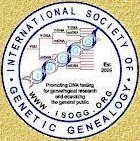
Explanation about
Genealogy and Genetics


|
Explanation aboutGenealogy and Genetics |

|
|
* What is a genealogy?A genealogy is a table with all members of a family. By family we do not mean a household here, but all persons who descend from father to son in male line from the same distant male ancestor. We call this oldest known man the ancestor. Because family names inherit from father to son, they all have the same surname. Sometimes there are branches with a different surname. This occurs when the genealogy goes back to a time when there were no surnames yet. Two brothers can then each have a different name as their last name. Sometimes you see that children take over the surname of their mother. There may be several reasons for this. One is that a child wants to prevent her name from dying out because there are no more male carriers. In a genealogy all persons get their own number. This number starts with a roman number behind which a letter follows. The Roman numeral indicates the generation. A generation is a staircase in the breeding sequence. The ancestor has I. His children are all II, the grandchildren are all III, and so on. In a household the eldest child gets the letter a added to it, the second b, etc. When a son marries and begets children, he gets a second place of his own. The first place is as a child in the household of his father. Here, his name is referred to the second place where he is described as an independent head of an household with wife and children In this next generation his Roman number is one higher than his father. The families of his brothers all get the same number. The eldest of the brothers gets the addition "a", that is to say: "IIa", at the next "IIb", etc. All cousins and distant of the same generation therefore have the same Roman numeral, each with a different letter. There are sometimes genealogists who devise an original new numbering themselves when creating their genealogy, which then becomes fluff work. * What is a ParenteelA Parenteel is just like a genealogy a table, but it is much more extensive because not only the descendants of the sons but also those of the daughters are included. So it is a genealogy with many different surnames. The numbering is the same as with a genealogy. * What is a pedigree chartA pedigree chart is a table with all the ancestors. He starts from one person, then the two parents, then the four grandparents. The four grandparents were called earlier one's four quarters. If in the past you wanted to be appointed in the knighthood of a province, then you had to be four grandparents of nobility. That was your pedigree chart. If you place all other ancestors in the table, we will continue to call this table a pedigree chart. We then call all individual persons quarters. Every quarter gets a number. Number 1 is the person you start with, usually yourself. His father is 2, mother 3, paternal grandfather 4, paternal grandmother 5, maternal grandfather 6, and so on. When you work with such a state for a while, you can see how easy the numbering is. The number of a father is always twice that of the child, the mother is double plus 1. Men always have an even number, women an odd one. The child-parent relationship is easy to find. No.20 is a son of 40. The mother of 20 is 41. The order of child, parents, grandparents, great-grandparents and so on is what we call generations. They are numbered with Roman numerals. * Genetic GenealogyGenetic genealogy (GG) is continuation of the common genealogy by other means. When the genealogical research ceases in archives and is nothing is mentioned anymore in magazines and books, it is nowadays possible to continue with genetic research. This is done when one expects to be related to a family with the same, or about the same, surname coming from the same region or city. It could also be that one of your foremothers was unmarried and you are looking for the biological father. When the research is successful, one has often done different tests and opens the rich world of genographic possibilities. A son of an English farm worker who was looking for his natural father, and indeed found it, became a geneticist, professor of genetics, Nobel Prize winner in genetic science and finally raised to British nobility. That was sir Paul Maxim Nurse. * What is GeneticsGenetics is the science that investigates the heredity of living beings. The hereditary properties lie in the DNA that is present in the nucleus of each body cell. This DNA lies in the chromosomes and the mitochondria. In the chromosomes the hereditary characteristics are Double built. In reproduction, sperm cells are produced in the male and egg cells in the female. These reproductive cells receive a complete singular package. After mating, the ovum and sperm cell melt together and an embryo is created that has received half of his hereditary qualities from his father and half from his mother and therefore has a double package again. GenA gene is a unit of hereditary material, with which organisms pass hereditary characteristics to their offspring. It consists of DNA and is located on a chromosome or in the mitochondrium. * What is DNADNA is an abbreviation of Desoxyribo Nucleic Acid. It is the code for the four nucleic acids, adenine (A), thymine (T), guanine (G) and cytosine (C), which occur in ever-changing combinations in the gene. We call them nucleotides. They always lie in pairs A with T and G with C. These are called base pairs. They are located on the chromosomes and on the mitochondrium ChromosomesChromosomes are in the body's cells. The human has 23 chromosomes that have been built twice, so 46 chromosomes. Of these 22 pairs are equal, the 23rd pair consists of two different parts, the X chromosome and the Y chromosome. The woman always has two X chromosomes. The man has both an X and a Y chromosome. A sperm cell of the father can therefore either contain the X or the Y chromosome. The sperm cell determines whether a child becomes XY, a son or XX, a daughter. The chromosomes have a total of 3 milliard base pairs. The X chromosome has 153,000 of these, the Y chromosome 60,000. All chromosomes are mentioned together the Autosome. MitochondrionThe mitochondrion or mitochondrium is part of the body cell. This small cell component is the power plant of the cell. It is outside the chromosomes. It contains also DNA and counts for only 16,569 base pairs. This is about a quarter of what the entire Y chromosome has. It inherited from the mother. It is called mtDNA after mitochondrium of maternal. Her sons and daughters inherit it equally, but only the daughters pass it on. Mutations When the DNA would always be inherited unchanged, it was unusable for humans and nature. No evolution would have taken place. In every generation, a change occurs in one of the genes, a mutation. In the genetic genealogy we use two types of mutations that can take place on the chomosome:
Alle mutations pass on from parent to child. Because of this the great diversity in plants and animals has arisen. MarkerA chromosome is divided into thousands of segments. The segments are named after their place in the row, DYS Y Segment DYS followed by an index number, for instance DYS19. Many segments have multiple copies of themselves. This varies between 8 and 50. This is the so called Short Tandem Repeat STR value. If DYS19 has 15 copies, it is called DYS19=15. This is then called a marker Once in the average of 100 generations, such a marker changes a unit. When you test on one hundred places, there is on average one mutation detectable in each generation. HaplotypeThe collection of DYS values that arose as a result of mutations in the ancestry of a man is called his haplotype. When you compare the haplotypes of two people, you count the number of different markers and so you can calculate the relationship. It is clear that this is not an exact but a global calculation. Close family members have the same haplotype, members of side branches have one or more differences (mutations) depending on the degree of kinship. There are two phenomena that reduce the accuracy even more. Over the generations, the number of repetitions can decrease again after an increase, or vice versa. Furthermore, there are major differences in the chances of mutation in the different DYS sites. Yet this method of kinship determination in the short term, and then we mean 20 generations or 600 years, is still usable. In any case, every STR mutation leads to one genetic distance. SNPThe Y chromosome has about 60 million sites. Under the current method of aligning DNA fragments to known sites of a reference sample, only about 30 million of these sites can be mapped. A significant number of the sites are similar in location to other sections of DNA and are not reliable for this reason. That means perhaps abt 13 million sites are useful. Of these, the Big Y checks for about 10 million of theser. Here the order of certain proteins can change. That is Single Nucleid Polymorphism, SNP. These loci less often than STRs and are stable. This allows them to be used to find relations that extend over longer periods of time, which can exceed hundreds to tens of thousands of years. Historians and ethnologists and use them. (1) HaplogroupThese are groups of people with their first same characteristic SNP. Each haplogroup has its own letter, from A to T, named after that first SNP. When a mutation occurs in such a group that has multiple lines of offspring, it leads again to a new subgroup. A number is then added to the letter, and for a subsequent subgroup a letter again. In the Y chromosome, 21 haplogroups are known to date. In this, many subgroups have arisen again, more than a thousand have already been registered. (2) Distribution of the Y-DNA haplogroups in the Netherlands and Belgium The first pie chart shows the ten largest Y-DNA haplogroups found in the Netherlands among 410 men in the year 2008.
The second gives the percentages in the Oudhertogdom Brabant Project at 1057 men in the year 2013.
|
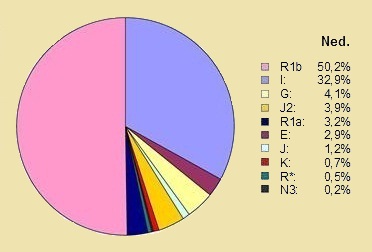
Haplogroup distribution in the Netherlands |
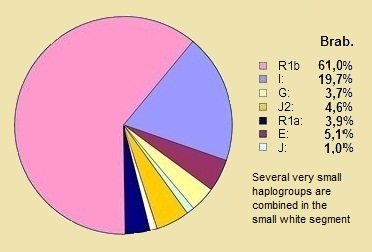
Haplogroup distribution in the Belgium |
GenomeThe genome is the complete hereditary information that is present in every cell of a living organism. In humans that is the DNA of the chromosomes, mitochondria and autosomes. It contains coding and non-coding genes. * Objectives for genetic researchGenetic genealogical research This is done for several reasons. You can do this to show if a person with a similar or nearly similar last name is related. If so, you can find out when the common ancestor lived.
Which tests Start by determining your haplotype and haplogroup. Then test your deepest subgroup in that haplogroup. There are several companies offering such a package. Then follow the advice given by the companies for further research.
* Research into an unknown recent ancestorThis research is mainly done by adopted children and children conceived by an anonymous sperm donor, and children conceived by an unknown father. Which testsDo an autosomal DNA test and in boys also an extensive Y-DNA test at organizations with a large database. Which testsFor example Familyfinder from FTDNA. and for boys also Y-DNA. * Create a matriarchal family treeThese are pedigrees that are based on a foundation mother instead of a progenitor. For this we test the mt-DNA because although all offspring get this from their mother, only the daughters pass it on. The family tree continues through them. The result is usually not very impressive. Mt DNA is only 5% the length of a Y DNA. It has no no STRs only SNPs. With Y-DNA they occur roughly every 150 years, with mt-DNA closer to 3,000 years. So there is little to make a family tree out of this.
Testen: Mt-DNA. |
|
* Companies and their products |

|

|

|

|
|
BigY |
Y Elite 2.1 |
Complete sequencing of the DNA |
SNP en STR tests |
|
* Research into predisposition to hereditary characteristics and diseases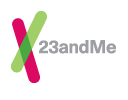
23andMe does autosomal research into hereditary diseases, and as a by-product provides clues about the geographical origin of the ancestors. Interesting is the percentage of contributions from prehomonids, such as from Neanderthals and Denisovans. |
*
Good BookBlaine T. Bettinger, The Family Tree Guide to DNA Testing and Genetic Genealogy. |
|
|
This describes the various reasons for doing a specific DNA test and which tests you can do for it. The most important DNA terms and codes are explained clearly. The most important companies where you can do a test are mentioned, and advice is given about which firm and test you can best choose for a specific research question. * A must on the web is Which test is best to purchase |
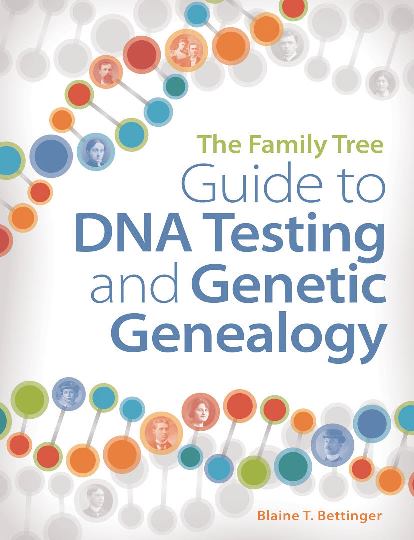
|
*
Face book Discussion groups Genetic GenealogyIt is highly advisable to discuss the advantages and disadvantages of the various tests with experiential experts and scientists before undertaking DNA research. For example in face book discussion groups. |
|
|
||
|
Last update: |
Webbeheerder: Boed Marres |